History and Evolution of Cloud Services: From Room-Sized Mammoths to Digital Sky Gardens 🕰️☁️
Welcome back, fellow cloud explorers! Yesterday, we dipped our toes into the vast ocean of cloud computing fundamentals. Today, we’re firing up our time machine to trace the fascinating evolution of cloud services – a journey that’s as colorful as it is revolutionary!
The Prehistoric Era: When Computers Needed Their Own Zip Code 🦕
1950s-1960s: The Mainframe Mammoths
Picture this: massive room-sized computers that hummed, clicked, and occasionally overheated while processing data at what we’d now consider a snail’s pace. These mainframes were so expensive that only large organizations and universities could afford them.
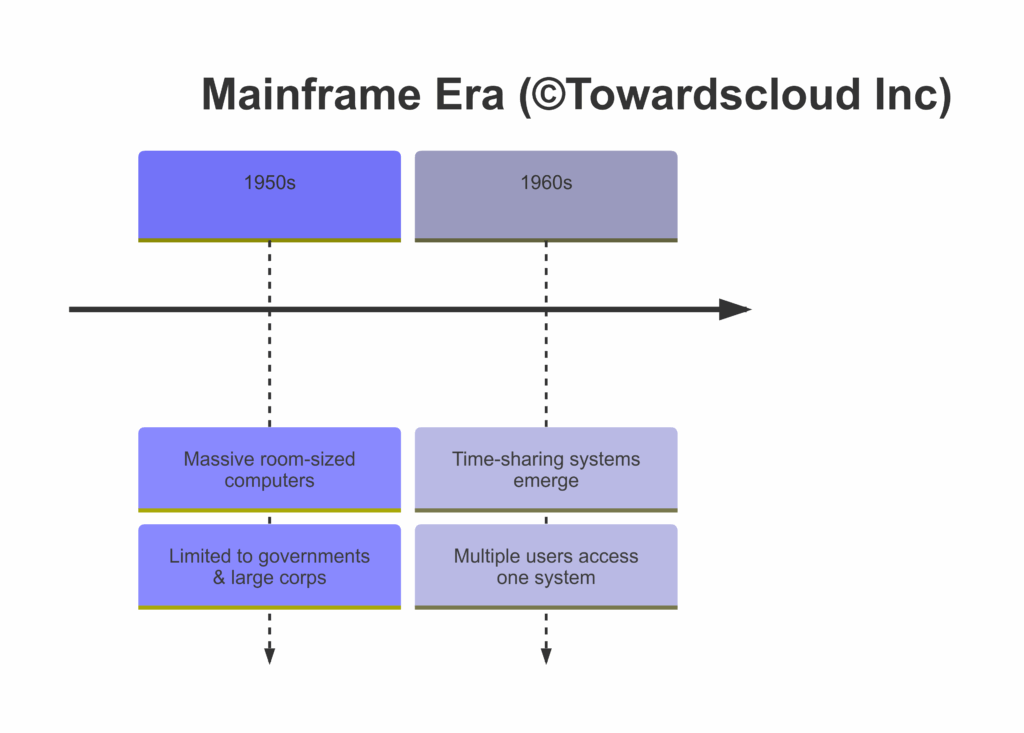
Users would schedule “computer time” like booking an appointment, often waiting days for their punch cards to be processed. Imagine explaining to your boss today that you’ll have those numbers ready by next Thursday – if your mainframe appointment doesn’t get rescheduled!
1970s: The First Whispers of Virtualization
IBM pioneered virtualization technology with VM/370, allowing mainframes to run multiple virtual machines simultaneously. This was revolutionary – one physical system could now host multiple isolated computing environments!
Think of it as the difference between having separate houses (computers) versus a single apartment building with multiple units (virtual machines). Efficiency was born, and the seeds of cloud computing were planted.
The Middle Ages: Networks Begin to Form 🌐
1980s: Personal Computing Revolution
While not directly cloud-related, the PC revolution laid crucial groundwork. Computers shrank from room-sized to desk-sized, and suddenly everyone wanted one. The problem? These isolated machines couldn’t easily share resources or data.
Enter networking technologies – the precursors to our modern internet. Local Area Networks (LANs) connected computers within buildings, while early Wide Area Networks (WANs) connected systems across distances.
1990s: The Internet Explosion and Early Service Providers
Cue dial-up modem sounds! 📞
The 90s brought us the web as we know it, complete with email, basic e-commerce, and that iconic “You’ve Got Mail” notification. More importantly for our cloud story, we saw the rise of Application Service Providers (ASPs) – companies that hosted and managed applications for multiple customers.
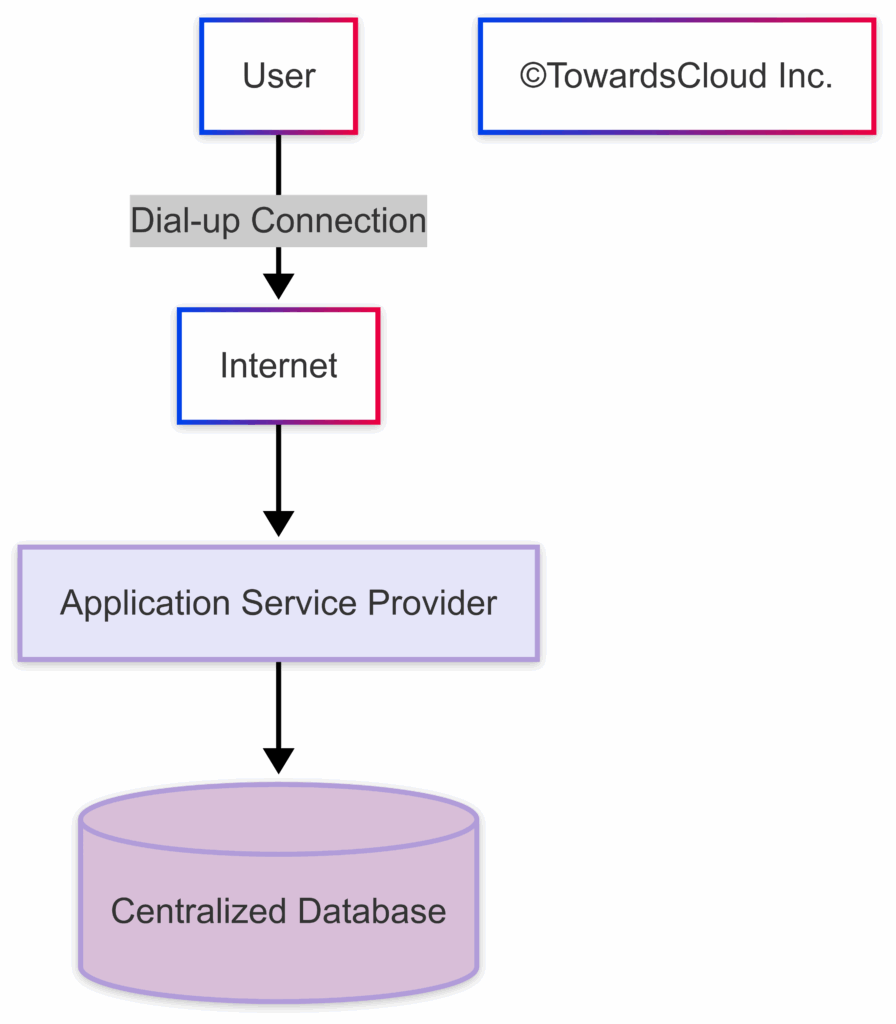
These ASPs were primitive cloud providers, offering centralized application hosting when most businesses still kept their servers on-premises. The concept was there, but bandwidth limitations and security concerns kept widespread adoption at bay.
The Renaissance: Cloud Computing Emerges ☁️
Early 2000s: The Term “Cloud Computing” Takes Flight
The term “cloud computing” gained traction as a metaphor for the complex network infrastructure that powered internet services. Why a cloud? Because network diagrams used cloud symbols to represent “the internet” – that mysterious place where data traveled between points.
In 2002, Amazon Web Services (AWS) launched its first web services, offering simple storage and computation capabilities. At this stage, it was more like “Web Services” than the full “Cloud Platform” we know today.
Mid-2000s: The True Cloud Revolution Begins
2006 was the watershed year. Amazon launched EC2 (Elastic Compute Cloud), allowing users to rent virtual computers by the hour. This was revolutionary! Suddenly, businesses didn’t need to purchase, house, and maintain expensive hardware. Instead, they could:
- Spin up servers on demand
- Pay only for what they used
- Scale up or down instantly
- Access their infrastructure from anywhere
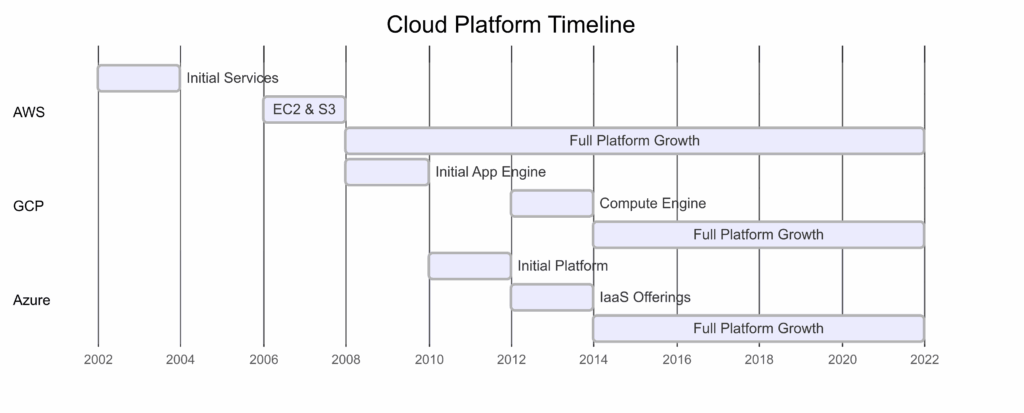
Google and Microsoft weren’t far behind, with Google App Engine launching in 2008 and Microsoft Azure in 2010. The cloud computing arms race had begun!
The Industrial Revolution: Cloud Transforms Business 🏭
2010s: The SaaS Explosion and Beyond
The 2010s saw cloud adoption skyrocket with Software as a Service (SaaS) becoming the dominant software delivery model. Applications like Salesforce, Dropbox, and Office 365 proved that software could live entirely in the cloud.
But the innovation didn’t stop there:
- Containerization: Docker (2013) revolutionized how applications are packaged and deployed, making them environment-agnostic.
- Serverless Computing: AWS Lambda (2014) introduced functions-as-a-service, letting developers focus purely on code without managing servers.
- Kubernetes: Google’s container orchestration system (2014) became the industry standard for managing containerized applications at scale.
Late 2010s: Multi-Cloud and Hybrid Strategies
As cloud services matured, organizations realized they didn’t need to commit to a single provider. Multi-cloud strategies emerged, letting companies mix and match services from different providers based on specific strengths:
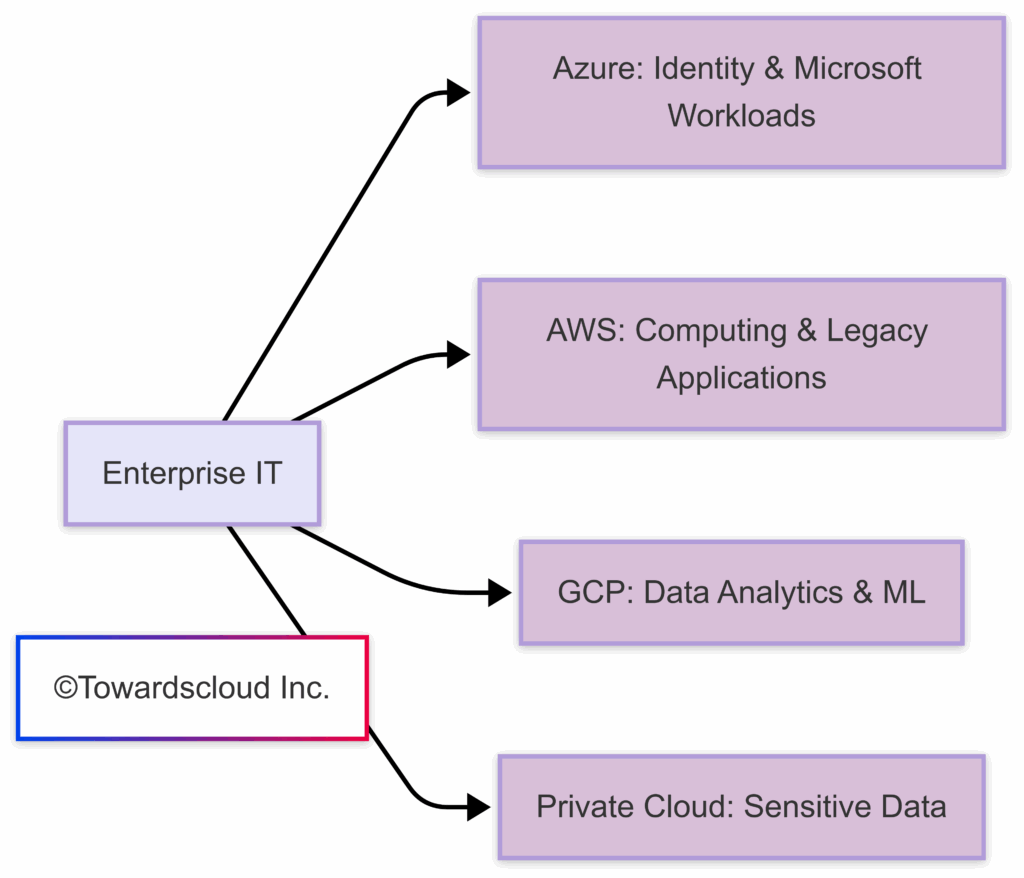
Meanwhile, hybrid cloud approaches combined private on-premises infrastructure with public cloud services, giving organizations the best of both worlds for security, compliance, and flexibility.
The Modern Era: Cloud is Foundational 🌟
2020s: Cloud Powers Everything
Today, cloud computing isn’t just one technology among many – it’s the foundation of modern IT. From AI and machine learning to IoT and edge computing, virtually all cutting-edge technologies rely on cloud infrastructure.
The COVID-19 pandemic accelerated cloud adoption further, as remote work became necessary rather than optional. Organizations that had resisted cloud migration found themselves with little choice but to embrace it.
Key developments of our current era include:
- AI/ML as a Service: Cloud providers offer sophisticated machine learning capabilities without requiring deep expertise.
- Edge Computing: Processing moves closer to the source of data for faster response times and reduced bandwidth.
- Serverless Everything: The serverless paradigm expands beyond functions to databases, containers, and more.
- FinOps: As cloud spending grows, financial operations practices emerge to optimize cloud costs.
Why Did Cloud Computing Succeed? 💰🔄🛡️
Three main factors drove cloud computing’s meteoric rise:
1. Economic Advantage
- Capital Expenditure → Operating Expenditure: No need for massive upfront hardware investments
- Pay-as-you-go: Only pay for resources you actually use
- Economies of Scale: Cloud providers pass on cost savings from their massive operations
2. Agility and Innovation
- Rapid Provisioning: Deploy infrastructure in minutes instead of months
- Global Reach: Access to worldwide data centers instantly
- Focus on Core Business: Less time managing infrastructure, more time creating value
3. Reliability and Security
- Redundancy: Multiple data centers ensure business continuity
- Expert Security Teams: Specialized professionals handling security challenges
- Constant Updates: Always running the latest, most secure software versions
Interactive Pop Quiz! 🧠
Question: Which cloud service model provides virtual machines, storage, and networking but requires users to manage the operating system and applications?
A) SaaS (Software as a Service) B) PaaS (Platform as a Service) C) IaaS (Infrastructure as a Service) D) FaaS (Function as a Service)
Think about it…
Answer: C) IaaS (Infrastructure as a Service)
Congratulations if you got it right! If not, no worries – we’ll dive deeper into cloud service models in tomorrow’s post!
The Future of Cloud Computing 🔮
As we look ahead, several exciting trends are emerging:
Quantum Computing in the Cloud
Cloud providers are starting to offer quantum computing resources, bringing this cutting-edge technology to organizations that could never afford their own quantum systems.
Sustainable Cloud
As data centers consume increasing energy, providers are focusing on sustainability, with commitments to renewable energy and carbon-negative operations.
AI-Driven Cloud Operations
Cloud environments increasingly manage themselves, with AI handling optimization, security, and healing with minimal human intervention.
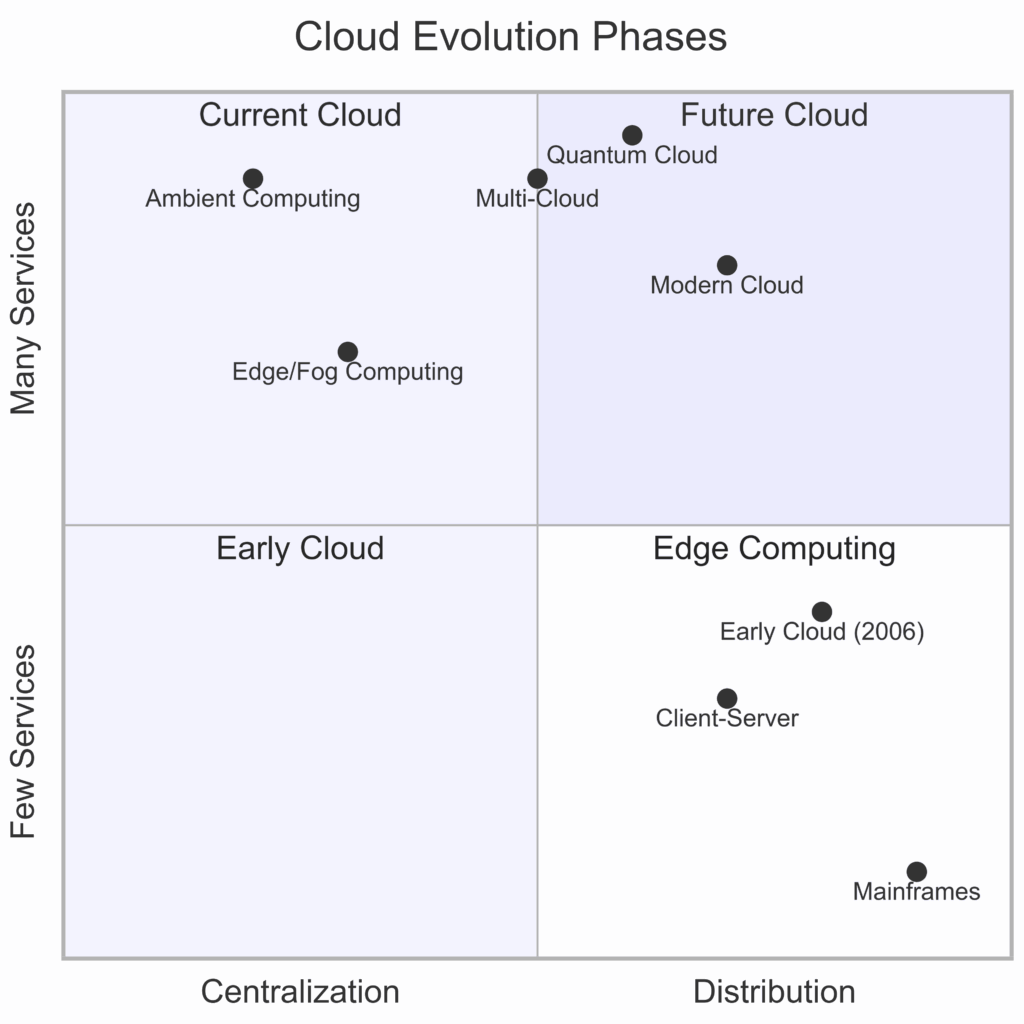
Wrapping Up: From Mainframes to the Stratosphere 🚀
The evolution of cloud computing represents one of the most significant shifts in how we build and consume technology. From room-sized computers accessed by the privileged few to ubiquitous computing power available to anyone with an internet connection, we’ve come an incredibly long way.
Next time you casually spin up a virtual machine, deploy a serverless function, or use a cloud-based application, take a moment to appreciate the decades of innovation that made it possible. We’ve gone from punch cards and scheduled computer time to infinite resources at our fingertips!
Coming Up Next! 📅
Tomorrow, we’ll explore the three main service models that define cloud offerings: IaaS, PaaS, and SaaS. We’ll break down what each model offers, who they’re best for, and how the major cloud providers implement them.
Question for our readers: What aspect of cloud computing history surprised you the most? Was there a particular innovation that changed how your organization operates? Share in the comments below!
Until later, keep your head in the clouds – that’s where the future is happening! ☁️✨
Did you find this article helpful? Share it with colleagues who might benefit from understanding the cloud’s evolutionary journey!